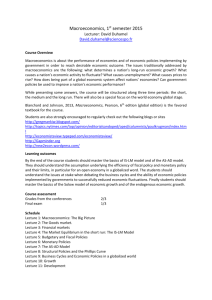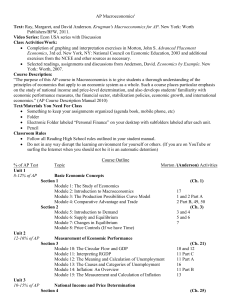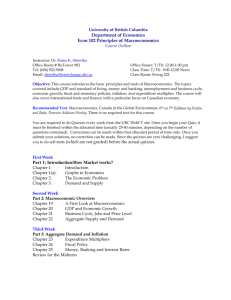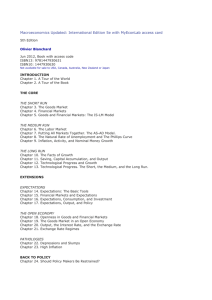417 syllabus - McDonald
advertisement
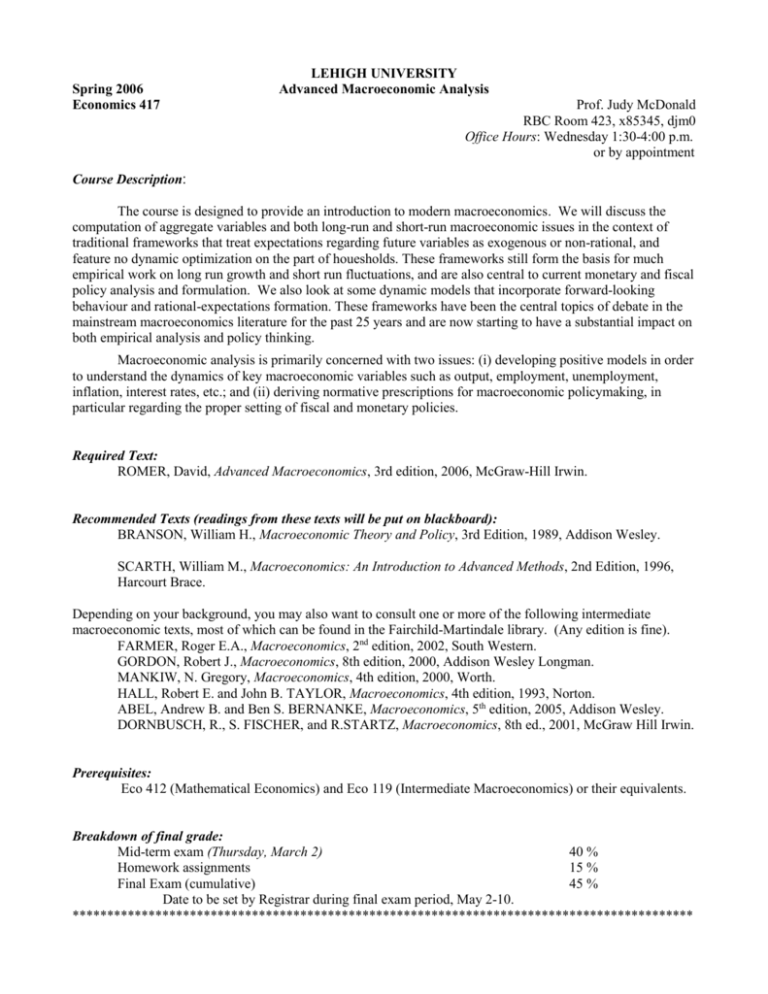
Spring 2006 Economics 417 LEHIGH UNIVERSITY Advanced Macroeconomic Analysis Prof. Judy McDonald RBC Room 423, x85345, djm0 Office Hours: Wednesday 1:30-4:00 p.m. or by appointment Course Description: The course is designed to provide an introduction to modern macroeconomics. We will discuss the computation of aggregate variables and both long-run and short-run macroeconomic issues in the context of traditional frameworks that treat expectations regarding future variables as exogenous or non-rational, and feature no dynamic optimization on the part of houesholds. These frameworks still form the basis for much empirical work on long run growth and short run fluctuations, and are also central to current monetary and fiscal policy analysis and formulation. We also look at some dynamic models that incorporate forward-looking behaviour and rational-expectations formation. These frameworks have been the central topics of debate in the mainstream macroeconomics literature for the past 25 years and are now starting to have a substantial impact on both empirical analysis and policy thinking. Macroeconomic analysis is primarily concerned with two issues: (i) developing positive models in order to understand the dynamics of key macroeconomic variables such as output, employment, unemployment, inflation, interest rates, etc.; and (ii) deriving normative prescriptions for macroeconomic policymaking, in particular regarding the proper setting of fiscal and monetary policies. Required Text: ROMER, David, Advanced Macroeconomics, 3rd edition, 2006, McGraw-Hill Irwin. Recommended Texts (readings from these texts will be put on blackboard): BRANSON, William H., Macroeconomic Theory and Policy, 3rd Edition, 1989, Addison Wesley. SCARTH, William M., Macroeconomics: An Introduction to Advanced Methods, 2nd Edition, 1996, Harcourt Brace. Depending on your background, you may also want to consult one or more of the following intermediate macroeconomic texts, most of which can be found in the Fairchild-Martindale library. (Any edition is fine). FARMER, Roger E.A., Macroeconomics, 2nd edition, 2002, South Western. GORDON, Robert J., Macroeconomics, 8th edition, 2000, Addison Wesley Longman. MANKIW, N. Gregory, Macroeconomics, 4th edition, 2000, Worth. HALL, Robert E. and John B. TAYLOR, Macroeconomics, 4th edition, 1993, Norton. ABEL, Andrew B. and Ben S. BERNANKE, Macroeconomics, 5th edition, 2005, Addison Wesley. DORNBUSCH, R., S. FISCHER, and R.STARTZ, Macroeconomics, 8th ed., 2001, McGraw Hill Irwin. Prerequisites: Eco 412 (Mathematical Economics) and Eco 119 (Intermediate Macroeconomics) or their equivalents. Breakdown of final grade: Mid-term exam (Thursday, March 2) 40 % Homework assignments 15 % Final Exam (cumulative) 45 % Date to be set by Registrar during final exam period, May 2-10. ****************************************************************************************** 2 COURSE OUTLINE AND READING LIST The following reading list should be considered a (very incomplete) list of references of some of the key papers in the various topics. All the required and recommended texts above have excellent lists of references. In the lectures the general line of research, past and present, will be discussed for as many topics as time permits. Classic, representative or important papers will be discussed in some detail. These will be posted to our website and you should read them before the class discussion. Additions or subtractions of topics and articles might be made based on our progress during the semester. I. Introduction to Macroeconomics ROMER, pp. 1-4 BRANSON, Chapters 1-3 Krugman on Macroeconomics “Size does matter: In defense of macroeconomics” http://www.pkarchive.org/theory/size.html Krugman on Formalism in Economics “Two cheers for formalism” http://www.pkarchive.org/theory/formal.html Mankiw, N.G., “Recent Developments in Macroeconomics: A Very Quick Refresher Course,” Journal of Money, Credit and Banking (JMCB) 20, 1988, pp. 436-449. Phelps, E.S., Seven Schools of Macroeconomic Thought, Oxford: Oxford University Press, 1990. II. The Keynesian versus the Classical Approach; Short-Run Keynesian Theory; The Static Equilibrium Model; and IS-LM Analysis ROMER, Chapter 5, pp. 222-250. BRANSON, Chapters 4-9 and 16 SCARTH, Chapters 2-4 Hicks, J.R., “Mr. Keynes and the Classics; A Suggested Interpretation,” Econometrica 5, no. 2, April 1937. Krugman on Keynes, “Why aren’t we all Keynesians yet?” http://www.pkarchive.org/theory/keynes.html Krugman on Macroeconomics “There’s something about macro” http://web.mit.edu/krugman/www/islm.html Krugman on Japan, “Japan’s trap,” http://web.mit.edu/krugman/www/japtrap.html and “Japan: Still trapped,” http://www.wws.princeton.edu/~pkrugman/japtrap2.html Models that extend the basic IS-LM analysis: Mundell, R.A., “Inflation and Real Interest,” Journal of Political Economy (JPE), June 1963. Peek, J., “Interest Rates, Income Taxes and Anticipated Inflation,” American Economic Review (AER), December 1982. Wilcox, J.A., “Why Real Interest Rates Were So Low in the 1970s,” AER, March 1983. 3 III. The Wage Curve, AS and the Phillips Curve ROMER, Chapter 5, pp. 251-266. BRANSON, Chapter 19 (Inflation and Productivity) and Chapter 20 (Inflation&UE: The Phillips Curve) Phillips, A.W., “The Relationship Between Unemployment and the Rate of Change of Money Wage Rates in the U.K., 1861-1957,” Economica 25, November 1958, pp. 283-299. Friedman, Milton, “The Role of Monetary Policy,” AER, March 1968, pp. 1-17. Blanchflower and Oswald, “An Introduction to the Wage Curve,” Journal of Economic Perspectives, 1995. IV. The New Classical Models or Rational-Expectation Models; The Lucas Critique ROMER, Chapter 6, pp. 271-285. BRANSON, Chapter 11 SCARTH, Chapters 5, 6, and 11 Cagan, Phillip, “Reflections on Rational Expectations,” Journal of Money, Credit, and Banking (JMCB), vol. 12, no. 4, November 1980, Part 2, pp. 826-836. Fama, Eugene, “Short-Term Interest Rates as Predictors of Inflation,” AER, vol. 65, no. 3, June 1975, pp. 269-282. Fischer, S., “Long-term Contracts, Rational Expectations, and the Optimal Money Supply Rule,” JPE, February 1977, pp. 191-206. Kydland, F. and E. Prescott, “Rules rather than Discretion: The Inconsistency of Optimal Plans,” JPE 87, June 1977, pp. 473-492. 4 Lucas, R.E., “Expectations and the Neutrality of Money,” Journal of Economic Theory, 1972. Lucas, R.E., “Econometric Policy Evaluation: A Critique,” in K. Brunner and A.H. Meltzer, eds., The Phillips Curve and the Labour Market, Amsterdam: North-Holland, 1976. Mankiw, G., “A Quick Refresher Course in Macroeconomics,” Journal of Economic Literature 28, 1990, pp. 1645-60. McCallum, B.T., “Rational Expectations and Macroeconomic Stabilization Policy: An Overview,” JMCB, vol. 12, no. 4 (November 1980, Part 2), pp. 716-746. McCallum, B.T., “Macroeconomics After a Decade of Rational Expectations: Some Critical Issues,” Federal Reserve Bank of Richmond Economic Review, November/December 1982, pp. 3-12. McCallum, B.T., “Macroeconomics After Two Decades of Rational Expectations,” Journal of Economic Education, volume 25, no. 3, Summer 1994, pp. 219-234. Okun, Arthur, “Rational-Expectations-with-Misperceptions as a Theory of the Business Cycle,” JMCB, vol. 12, no. 4, November 1980, part 2, pp. 817-825. Sargent, T.J. and N. Wallace, “Rational Expectations and the Theory of Economic Policy,” JME, April 1976, pp. 169-184. Sargent, T.J. and N. Wallace, “'Rational' Expectations, the Optimal Monetary Instrument, and the Optimal Money Supply Rule,” JPE, 1975, pp. 241-254. Sheffrin, S.M., Rational Expectations, Cambridge: Cambridge University Press, 1983. Taylor, J.B., “Staggered Wage Setting in a Macro Model,” AER 69, 1979, pp. 108-113. Background material on dynamic macroeconomics: FARMER, Chapter 14 Obstfeld, Maurice. 1992. “Dynamic Optimization in Continuous-Time Economic Models (A Guide for the Perplexed)” Part 1. http://emlab.berkeley.edu/users/obstfeld/ftp/perplexed/cts4a.pdf Dorfman, Robert. 1969. “An Economic Interpretation of Optimal Control Theory,” AER 59, pp. 817-831. V. Consumption and Investment ROMER, Chapters 7 and 8 BRANSON, Chapters 12 and 13 Abel, A., “Consumption and Investment,” NBER Working Paper No. 2580, May 1988. Hall, R.E., “Stochastic Implications of the Life Cycle-Permanent Income Hypothesis: Theory and Evidence,” JPE 86, December 1978, pp. 971-988. Jorgenson, D., “Economic Studies of Investment Behaviour: A Survey,” Journal of Economic Literature, December 1971. Mankiw, G., “Hall's Consumption Hypothesis and Durable Goods,” JME 10, 1982, pp.417- 425. 5 VI. The Demand for and Supply of Money; Monetarism; Active Monetary Policy and the Taylor Rule ROMER, Chapter 10 BRANSON, Chapters 14 and 15 Baumol, W.J., “The Transactions Demand for Money: An Inventory Theoretic Approach,” Quarterly Journal of Economics (QJE), 1952. Branson, W., “Asset Markets and Relative Prices: A Portfolio-Balance Model,” mimeo. Goldfeld, S.M. and D.E. Sichel, “The Demand for Money,” Chapter in Handbook of Monetary Economics, ed. by B.M. Friedman and F.H. Hahn, pp. 299-356. New York: Elsevier Science. Judd, John and Glenn Rudebusch, “Taylor’s Rule and the Fed: 1970-1997,” Federal Reserve Board of San Francisco Economic Review, No. 3, 1998. McCallum, B.T., Monetary Economics, 1989. Poole, W., “Optimal Choice of Monetary-Policy Instruments in a Simple Stochastic Macro Model,” QJE, May 1970, pp. 197-216. Romer, C.D. and D. Romer, “Does Monetary Policy Matter? A New Test in the Spirit of Friedman and Schwartz,” NBER Macroeconomics Annual 4, 1989, pp. 121-170. Tobin, J., “The Interest-Elasticity of Transactions Demand for Cash,” Review of Economics and Statistics 38, August 1956, pp. 241-247. Tobin, J., “Liquidity Preference as Behaviour Towards Risk,” Review of Economic Studies, February 1958. Tobin, J., “General Equilibrium Approach to Monetary Theory,” JMCB, 1969, pp. 15-29. VII. Neoclassical Growth Models and Fiscal Policy: The Ramsey-Cass-Koopmans and the Diamond Models ROMER, Chapters 1, 2, 3, and 11 (pp. 559-579) FARMER, Chapters 15 Cass, David. 1965. “Optimum Growth in an Aggregative Model of Capital Accumulation,” Review of Economic Studies 32, pp. 233-240. Diamond, Peter. 1965. “National Debt in a Neoclassical Growth Model,” AER 55, pp. 1126-1150. VIII. New Keynesian Theories and the New Neoclassical Synthesis ROMER, Chapters 6 and 9 SCARTH, Chapter 10 Goodfriend, M. and R. King. 1997. “The New Neoclassical Synthesis and the role of Monetary Policy,” in B. Bernanke and J. Rotenberg (eds.) NBER Macroeconomics Annual 1997. MIT Press, pp. 231-83. IX. Endogenous Growth Models 6 ROMER, Chapter 3 FARMER, Chapter 16 Lucas, R. 1988. “On the Mechanics of Economic Development,” JME 22, pp. 3-42. X. Open-Economy Macroeconomics BRANSON, Chapter 17 SCARTH, Chapters 8 and 9 Krugman on Mundell (and Canada), “O Canada,” http://www.pkarchive.org/global/canada.html Branson, William, “Asset Markets and Relative Prices in Exchange-Rate Determination,” Princeton University, International Finance Section, Reprint No. 20, June 1980. Dornbusch, R., “Expectations and Exchange-Rate Dynamics,” JPE 84, December 1976, pp. 1161-1176. Fleming, J.M., “Domestic Financial Policies under Fixed and under Floating Exchange Rates,” IMF Staff Papers 9(3), 1962, pp. 369-379. Mundell, Robert, “Capital Mobility and Stabilization Policy under Fixed and Flexible Exchange Rates,” Canadian Journal of Economics and Political Science, November 1963, pp. 475-485. Copyright 1990 The Economist Newspaper Ltd. The Economist November 3, 1990, pp. 84-85. SCHOOLS BRIEF; Paradigm lost SERIES: Our new series looks at ten modern classics of economics -- the academic articles of recent years that have done most to shape the way economists think. Starting next week, each brief will explore one article. This introduction to the series sets the scene ******************************************* FOR roughly 25 years after 1950, despite all the cliches about economists never agreeing, it was fair to talk of a broad academic consensus on the big economic questions. Almost all economists were believers in what they called the "neoclassical synthesis". In the mid-1970s, thanks to a mixture of theoretical argument and unhelpful economic events, this consensus broke down. Economists have been trying to repair it ever since, but with little success. The neoclassical synthesis was so named because it claimed to unite what was valuable in classical economics with the Keynesian theories that had set out to refute classicism. In this blending of schools, the classical tradition supplied the underpinnings and the methodology -- notably, (a) the idea that economic agents (firms, workers, consumers) are rational; and (b) the technique of describing an economy as a series of markets (for goods, labour, money) in which prices adjust to maintain a balance of supply and demand. The trouble was that classical economics was notoriously bad at accounting for a particular sort of excess supply -- that of labour, otherwise called unemployment. Rational agents and unfettered markets ought, it seemed, to keep an economy fully employed. Jobless workers would force wages down, thus spurring the demand for labour. In the classical tradition it follows that the persistently unemployed are out of work by choice; the jobless simply prefer not to work at the offered wage. That was unconvincing, especially after the Great Depression of the 1930s. The Keynesian revolution obliged the classical apparatus to confront a variety of questions, but "What causes unemployment?" was the most important. Then came a paradox. While challenging, often ridiculing, the classical orthodoxy, Maynard Keynes and his followers supplied the insights that the neoclassical synthesis would use to rescue the classical approach. Of these, the most crucial was the notion of sticky prices -- the idea that prices (and especially wages, the price of labour) move sluggishly. 7 Agents were still in rational pursuit of self-interest; markets were still a good way to carve up an economy for inspection. In these respects, the Keynesian macro-economy was still "classical". But slow-changing prices make a big difference to the way an economy behaves, especially in the short run. Suppose that firms for some reason reduce their demand for labour. In the classical model, wages would quickly fall; that would restore "full employment" partly because at the new, lower wage, firms would demand more labour and partly because some workers would decide to drop out of the labour force (ie, they would become unemployed by choice). If wages are sticky, however, more workers will want jobs than firms are willing to hire. There will be an excess supply of labour -- unemployment -- at least for a time. Gradually, even in a Keynesian world, excess supply in the labour market will drive wages down, which in turn will restore full employment. So in the long term (when "we are all dead") the economy will look classical. In the short term it will be plagued -- just as in real life -- by spells of unemployment. Classic Keynes The neoclassical synthesis thus combined a Keynesian short run and a classical long run. It also combined, in effect, a demand side and a supply side. The demand side was developed in great detail thanks to Sir John Hicks at Oxford and, later, Harvard's Mr Alvin Hansen. They designed the model that is familiar to anybody who has studied economics in the past 40 years: IS-LM analysis. Many others, led by luminaries such as Mr Paul Samuelson of MIT and Mr James Tobin of Yale, built towers of sophisticated analysis on the Hicks-Hansen foundation. The neoclassical synthesis ruled for so long because of the expositional brilliance of the IS-LM approach. This reduced six crucial economic relationships to a simple diagram of two crossing lines, plotted with interest rates on one axis and output (aggregate demand, to be accurate) on the other. The simplest IS line embodies: an equation explaining consumption (the consumption function); another explaining investment; and the rule that, in equilibrium, savings equals investment. The simplest LM line embodies: an equation explaining the "transactions" demand for money; another explaining the "speculative" demand for money; and a second equilibrium rule, which says that the demand for money must equal the supply of money (itself fixed bygovernment, and thus determined outside the system). The IS line looks at the market for goods and says that, as interest rates fall, aggregate demand increases (thanks to more investment and consumption); it therefore slopes downwards. The LM line looks at the market for money and says that, as aggregate demand increases, interest rates rise (because higher aggregate demand also raises the demand for money); the LM line therefore slopes upwards. The economy is in equilibrium only where the lines cross. At every other point, one or more of the six relationships underlying the diagram will be out of kilter. The neoclassical synthesis explained supply by looking at the labour market. The idea was to account for the level of employment; via another equation (the "production function"), the amount of labour employed would then determine the economy's output. This is where sticky wages come in. If wages in money terms are fixed (Keynes's assumption), then a rise in the overall price level will temporarily reduce wages in real terms, stimulate the demand for labour and raise output and employment. A fall in prices will raise the real wage, depress the demand for labour and lead to lower output and employment. The sticky-wage description of the labour market was married to the IS-LM framework to produce an integrated model of aggregate demand and supply. This was the engine-room of the big computerised forecasting models that began to be built in the 1960s -- the heyday of economics as a quantitative science for making the world more prosperous. For years it was also the starting-point for almost all macroeconomic research. The downfall of the neoclassical synthesis was its account of inflation. Early versions of the IS-LM approach were easy to reconcile with the Phillips curve. First described by Mr William Phillips in a paper in 1958, the Phillips curve was not a theory, but a statistical observation. It said that low unemployment went hand in hand with high inflation, and vice versa. Recall, the IS-LM approach had said that a one-off rise in prices could lower real wages, temporarily boosting output and employment. Perhaps persistently rising prices -- inflation -- could buoy output and employment for longer, as the Phillips 8 curve said. Meltdown Friedman It all seemed to fit. Economists were soon talking about the trade-off between inflation and unemployment. Governments were told that aiming for price stability, desirable in its own right, would mean throwing people out of work. The question was how to exploit the output-inflation trade-off. In 1968 separate papers by Messrs Milton Friedman of the University of Chicago and Edmend Phelps of the University of Pennsylvania left this theory in shreds. Their work looked at the microeconomic underpinnings. Suppose, as the neoclassical synthesis said, inflation depresses the real wage and thus increases the demand for labour. What about the supply of labour? If workers are unwilling to supply as much labour as before, the increased demand for labour may not cause employment to rise. True, if workers are mistaken about real wages -- if they do not understand that higher prices have cut them -- a stronger demand for labour will boost employment. But for the Phillips curve to be true in this way, workers would have to keep making the same mistake. The annual inflation rate might have been 10% for years, but workers would need to keep on expecting prices to be stable next year; otherwise they would make good their real-wage cut by demanding higher money wages. This is a ridiculous assumption. Persistent inflation cannot keep coming as a surprise. Ever-rising inflation might; in that case there would be a trade-off between output and the rate at which inflation accelerates. But even this would be temporary. People would learn to anticipate rising inflation just as they learn to anticipate stable inflation. The upshot of the Friedman-Phelps attack was the expectations-augmented Phillips curve. This says that if inflation is fully expected, there is no trade-off between inflation and employment. A Phillips curve only appears, and then briefly, when the economy's expectations are upset by a surprise. With hindsight, the Friedman-Phelps attack was all the more impressive because it was launched when facts, as opposed to theory, still seemed in tune with the old Phillips curve. (Historical episodes of hyperinflation alongside massive unemployment could be dismissed as special cases.) Messrs Friedman and Phelps insisted that the Phillips curve would break down. It did. The 1970s brought stagflation -- high inflation and high unemployment, which the old Phillips curve had said did not happen. Messrs Friedman and Phelps were vindicated, the neoclassical synthesis was refuted, and the consensus of 25 years fell apart. Interesting times For the past 15 years, economists have been searching for a new paradigm to replace the neoclassical synthesis. One group is led by Messrs Robert Lucas of the University of Chicago and Thomas Sargent of Stanford. In the spirit of the FriedmanPhelps attack, their New Classical school works on the presumption that markets clear. Another loose coalition, the New Keynesians, challenges that presumption; but, again learning from Messrs Phelps and Friedman, its adherents are careful to explore the microeconomic causes of market failure. The neoclassical synthesis continues to exert a powerful influence on economic thinking. IS-LM analysis is still the way most students first learn their macroeconomics, and much research in recent years can be understood as modifying or refining the old model. An IS-LM system is still the core of most econometric models. However, macreconomic forecasting, for reasons to be explained in the next brief, has lost its academic respectability. Few of today's leading theorists find it fruitful to cast their ideas in terms of the old framework. This is the biggest reason why, in the modern debate among and within the different schools, economists talk past each other. The breakdown of the neoclassical synthesis has affected not just macroeconomics, but other branches of economics, too. The new stress on microeconomic foundations, and on the difficult mathematical techniques that are needed to explore them (see box), is altering the character of the whole subject. In some ways, as a result, economics has become more inward-looking than ever before. But economics is also learning to tackle entirely new questions of practical importance. 9 The coming briefs in this series will show that no new synthesis is yet in sight -- but that economics is livelier and more interesting than for many years.
